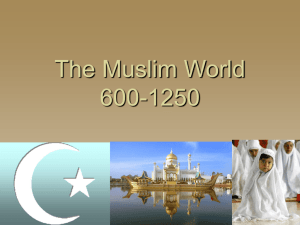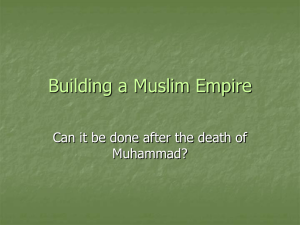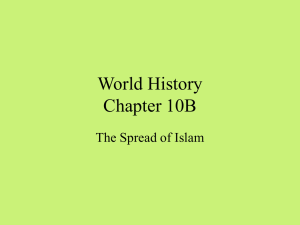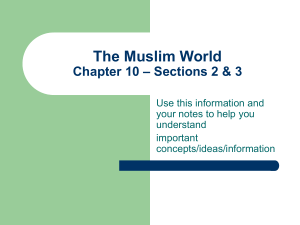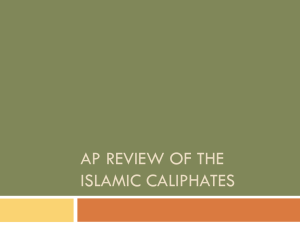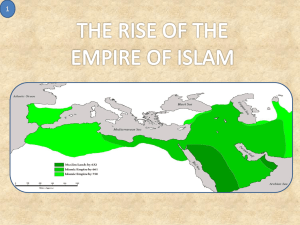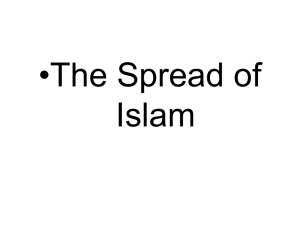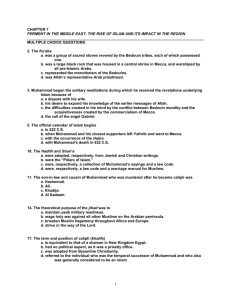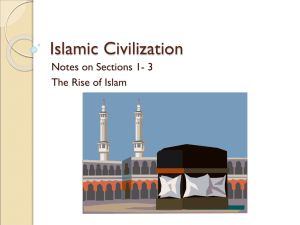The Spread of Islam
advertisement
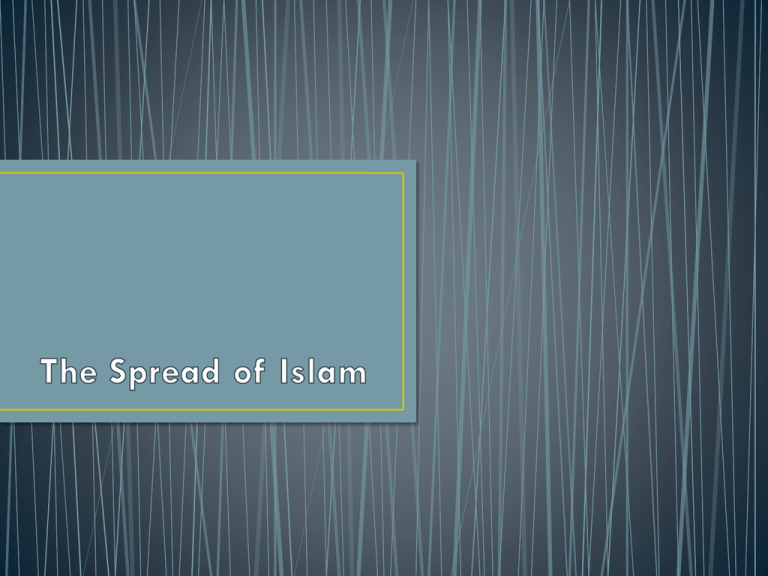
• Student will demonstrate knowledge of Islamic civilization from about 600 to 1000 C.E. by • Assessing the influence of geography on Islamic economic, social, and political development, including the impact of conquest and trade • Identifying historical turning points that affected the spread and influence of Islamic civilization • Essential Questions • How did geography influence the rapid expansion of territory under Muslim rule? • How did political and cultural geography facilitate trade and cultural activity in the early Islamic lands? • What were some turning points that marked the spread of and influence of Islamic civilization? Islam swept across Arabian Peninsula in 10 years between the Hijrah and Muhammad’s death Spread along trade routes from Mecca and Medina Expanded great distances despite geographical barriers Appeal Clear and straightforward requirements for human conduct Firm promises of heavenly reward All Muslims spoke Arabic Conversion Non-violent Toleration of Christian, Jews economically Violent After Muhammad’s death Caliphs urged jihads “holy wars” to spread Islam • In 632 C.E., the prophet Muhammad passed away without naming a successor • The Muslim community elected Abu-Bakr as their new leader • Became the first caliph • Reasons for military success • Faith of the Muslims soldiers • Armies were well-disciplined and expertly commanded • Weakness of the Byzantine and Persian empires • Persecution of Byzantine and Persian populations • Saw Muslims as liberators • The first four elected caliphs used the Qur’an and • Treatment of conquered peoples Muhammad’s leadership to guide • Many conquered people converted them to Islam • called the rightly guided caliphs • Used military force to assert authority • Conquered the fertile crescent, parts of the Byzantine and Persian empires • By 750 C.E. empire over 6,000 miles • Appeal, didn’t have to pay a poll tax • Allowed others to retain religion • 700s • Use of “Greek Fire” by Byzantines • Prevented Muslim army from conquering Constantinople until 1453 C.E. • 732 C.E. • Battle of Tours • Charles Martel • Stopped Muslim expansion into Europe • Later Expansion • The Crusades • Jerusalem • Damascus • In 656 the third caliph Uthman was murdered and triggered a civil war • Ali, Muhammad’s cousin and son-in-law became the 4th caliph • His rule was challenged • Ali was murdered in 661 C.E. • A family known as the Umayyads came to power • Set up a hereditary system of succession • Moved capital to Damascus, Syria • Some Arab Muslims were angry that the Umayyad's abandoned the simple life and surrounded themselves with wealth and ceremony • Led to a division in Muslim community • A minority group resisted • A third group called the Sufi pursued a life of Umayyad rule • This group called the Shi’a • Believed the caliph needed to be a relative of Muhammad • Those who followed the rule of the Umayyad became known as the Sunni • Followers of Muhammad’s example poverty and devotion to a spiritual path • Tried to achieve direct contact with God through mystical means • Similar to Christian or Buddhist monks • caliph should be chosen by leaders of the Muslim community • viewed caliphs as leaders, not religious authorities • believed that the only true successor to Muhammad were descendants of Muhammad’s daughter and son-in-law (Fatima and Ali) • comprise 90% of Islam followers • believed descendants were divinely inspired • most are located in Iran, Lebanon, Iraq, and Yemen • 750 C.E. • Shiites revolted against Umayyaads created own dynasty called “Abbassid” dynasty • Murdered remaining members of Umayyad family • One escaped and set up a dynasty in Spain, merged with Berber armies • Moved new capital to Baghdad in 762 C.E. • Location on a key trade route • Abbasid Dynasty • Built strong bureaucracy • Sent diplomats throughout the world • Caliphate would last from 750 C.E. to 1258 C.E. • Baghdad fell to the Mongols • Independent Muslim states continued to spring up in smaller regions • Fatimid Dynasty • Named after Muhammad’s daughter Fatima • Began in North Africa and spread from Red Sea to western Arabia and Syria • Two major trading sea trading zones • Mediterranean Sea • Indian Ocean • Land network connected to the silk road • Contacts from China to Europe and Africa • Unification of Muslim world • Single language- Arabic • Currency- Abbasid dinar • To encourage flow of trade, Muslims set up banks throughout the empire • Early forms of credit and checks


